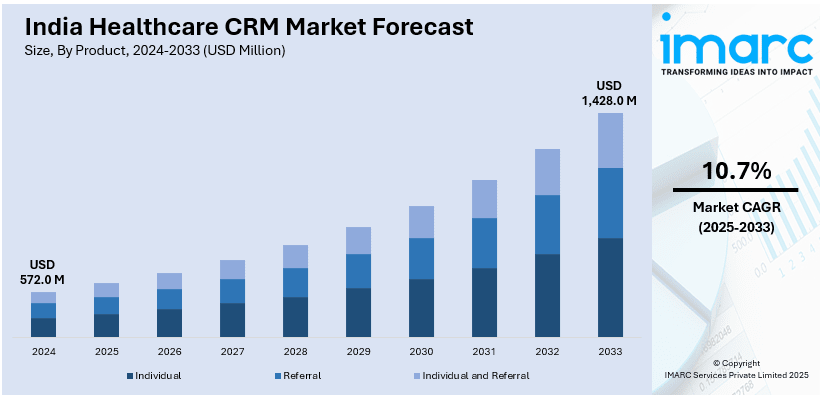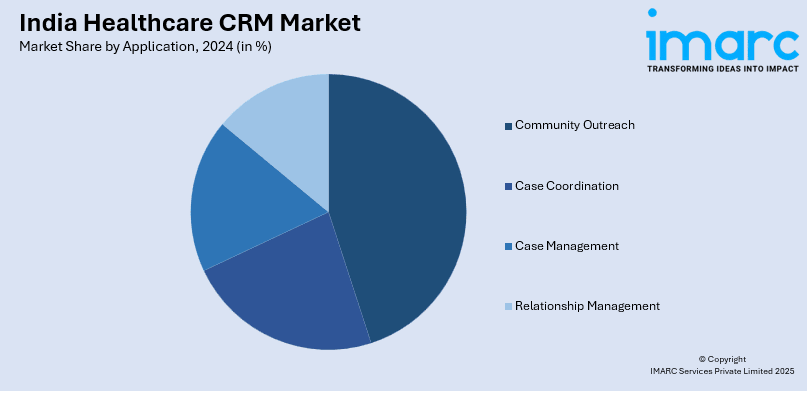
India Healthcare CRM Market Size, Share, Trends and Forecast by Product, Application, Technology, End Use, and Region, 2025-2033
India Healthcare CRM Market Overview:
The India healthcare CRM market size reached USD 572.0 Million in 2024. Looking forward, IMARC Group expects the market to reach USD 1,428.0 Million by 2033, exhibiting a growth rate (CAGR) of 10.7% during 2025-2033. The market share is expanding, driven by the expansion of healthcare facilities, leading to the widespread adoption of new digital solutions, along with the growing usage of artificial intelligence (AI)-based automation tools that aid in streamlining billing and claims processing.
|
Report Attribute
|
Key Statistics
|
|---|---|
|
Base Year
|
2024
|
|
Forecast Years
|
2025-2033
|
|
Historical Years
|
2019-2024
|
| Market Size in 2024 | USD 572.0 Million |
| Market Forecast in 2033 | USD 1,428.0 Million |
| Market Growth Rate (2025-2033) | 10.7% |
India Healthcare CRM Market Trends:
Growing investments in healthcare infrastructure
The increasing expenditure on healthcare infrastructure is propelling the India healthcare CRM market growth. The Indian Union Budget for 2024-25 allocated INR 89,287 Crores (USD 10.70 Billion) to the enhancement of the healthcare sector. The funding was aimed at boosting digital infrastructure, improving accessibility, and fostering innovations in healthcare services. With new hospitals, specialist clinics, and diagnostic centers opening across the country, there is a high demand for efficient systems to manage patient data, appointment scheduling, invoicing, and follow-ups. Healthcare CRM systems facilitate communication among doctors, patients, and support personnel, making the entire process more structured and hassle-free. As medical facilities are investing in new technologies, they are integrating CRM systems to tailor patient encounters, provide automated reminders, and improve overall service quality. Private healthcare chains and multi-specialty hospitals are focusing on refining the patient experience via digital platforms. As more hospitals modernize their operations, the demand for healthcare CRM solutions increases, making patient engagement and administration more seamless throughout India.

To get more information on this market, Request Sample
Increasing adoption of AI in healthcare
The rising employment of AI is offering a favorable India healthcare CRM market outlook. Hospitals are employing AI-based solutions to enhance patient management and improve diagnosis. With the growing patient load in hospitals and clinics, AI-oriented CRMs are helping healthcare professionals manage patient records more effectively, reducing errors and refining response times. AI-focused insights also aid doctors in tracking patient history, suggesting personalized treatment plans, and identifying potential health risks based on previous data. Many hospitals are using AI chatbots to answer patient queries, schedule consultations, and send reminders for follow-ups, reducing the burden on healthcare staff. Additionally, AI-based automation is streamlining billing, claims processing, and medical report management, making operations more efficient. The government’s encouragement for digital healthcare and AI integration in medical services is further supporting this trend. Telemedicine platforms are also assimilating AI-oriented CRMs to provide remote consultations and ensure better patient engagement. As the adoption of AI in healthcare systems continues to rise, CRMs are becoming essential tools for improving patient experiences and delivering more accurate healthcare services across India. According to the IMARC Group, the India AI in healthcare market is set to attain USD 4,165.3 Million by 2033, showing a growth rate (CAGR) of 30.78% during 2025-2033.
India Healthcare CRM Market Segmentation:
IMARC Group provides an analysis of the key trends in each segment of the market, along with forecasts at the regional level for 2025-2033. Our report has categorized the market based on product, application, technology, and end use.
Product Insights:
- Individual
- Referral
- Individual and Referral
The report has provided a detailed breakup and analysis of the market based on the product. This includes individual, referral, and individual and referral.
Application Insights:

- Community Outreach
- Case Coordination
- Case Management
- Relationship Management
A detailed breakup and analysis of the market based on the application have also been provided in the report. This includes community outreach, case coordination, case management, and relationship management.
Technology Insights:
- Cloud Based
- Mobile
- Social
- Collaborative
- Predictive
The report has provided a detailed breakup and analysis of the market based on the technology. This includes cloud based, mobile, social, collaborative, and predictive.
End Use Insights:
- Payers
- Providers
- Life Science Companies
A detailed breakup and analysis of the market based on the end use have also been provided in the report. This includes payers, providers, and life science companies.
Regional Insights:
- North India
- South India
- East India
- West India
The report has also provided a comprehensive analysis of all the major regional markets, which include North India, South India, East India, and West India.
Competitive Landscape:
The market research report has also provided a comprehensive analysis of the competitive landscape. Competitive analysis such as market structure, key player positioning, top winning strategies, competitive dashboard, and company evaluation quadrant has been covered in the report. Also, detailed profiles of all major companies have been provided.
India Healthcare CRM Market News:
- In January 2025, Docfyn introduced an AI-based marketing suite to transform hospitals and clinics in India. Besides acquiring patients, the suite aimed to boost patient retention, optimize workflows, and increase ROI. Website development for hospitals, chatbots, and CRM systems and SEO enhancement were included in its extensive services, assisting hospitals in maximizing potential without straining resources or workforce in India.
- In February 2024, Narayana Health, a prominent healthcare provider in India, teamed up with Salesforce, the top AI CRM leader, to offer CRM tools and solutions that could support the healthcare sector. In the coming phases, both firms intended to broaden the availability of healthcare services to beneficially affect the lives of additional patients throughout India.
India Healthcare CRM Market Report Coverage:
| Report Features | Details |
|---|---|
| Base Year of the Analysis | 2024 |
| Historical Period | 2019-2024 |
| Forecast Period | 2025-2033 |
| Units | Million USD |
| Scope of the Report |
Exploration of Historical Trends and Market Outlook, Industry Catalysts and Challenges, Segment-Wise Historical and Future Market Assessment:
|
| Products Covered | Individual, Referral, Individual and Referral |
| Applications Covered | Community Outreach, Case Coordination, Case Management, Relationship Management |
| Technologies Covered | Cloud Based, Mobile, Social, Collaborative, Predictive |
| End Uses Covered | Payers, Providers, Life Science Companies |
| Regions Covered | North India, South India, East India, West India |
| Customization Scope | 10% Free Customization |
| Post-Sale Analyst Support | 10-12 Weeks |
| Delivery Format | PDF and Excel through Email (We can also provide the editable version of the report in PPT/Word format on special request) |
Key Questions Answered in This Report:
- How has the India healthcare CRM market performed so far and how will it perform in the coming years?
- What is the breakup of the India healthcare CRM market on the basis of product?
- What is the breakup of the India healthcare CRM market on the basis of application?
- What is the breakup of the India healthcare CRM market on the basis of technology?
- What is the breakup of the India healthcare CRM market on the basis of end user?
- What is the breakup of the India healthcare CRM market on the basis of region?
- What are the various stages in the value chain of the India healthcare CRM market?
- What are the key driving factors and challenges in the India healthcare CRM?
- What is the structure of the India healthcare CRM market and who are the key players?
- What is the degree of competition in the India healthcare CRM market?
Key Benefits for Stakeholders:
- IMARC’s industry report offers a comprehensive quantitative analysis of various market segments, historical and current market trends, market forecasts, and dynamics of the India healthcare CRM market from 2019-2033.
- The research report provides the latest information on the market drivers, challenges, and opportunities in the India healthcare CRM market.
- Porter's five forces analysis assist stakeholders in assessing the impact of new entrants, competitive rivalry, supplier power, buyer power, and the threat of substitution. It helps stakeholders to analyze the level of competition within the India healthcare CRM industry and its attractiveness.
- Competitive landscape allows stakeholders to understand their competitive environment and provides an insight into the current positions of key players in the market.
Need more help?
- Speak to our experienced analysts for insights on the current market scenarios.
- Include additional segments and countries to customize the report as per your requirement.
- Gain an unparalleled competitive advantage in your domain by understanding how to utilize the report and positively impacting your operations and revenue.
- For further assistance, please connect with our analysts.
 Request Customization
Request Customization
 Speak to an Analyst
Speak to an Analyst
 Request Brochure
Request Brochure
 Inquire Before Buying
Inquire Before Buying




.webp)




.webp)












